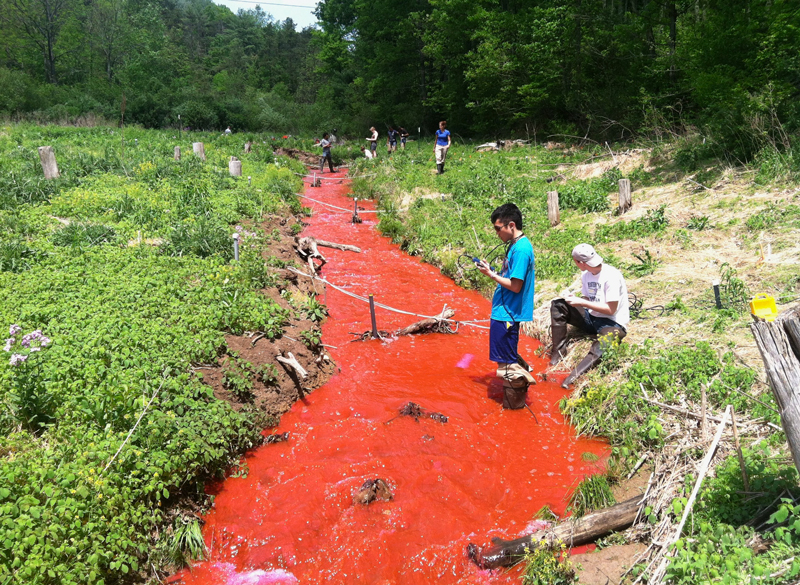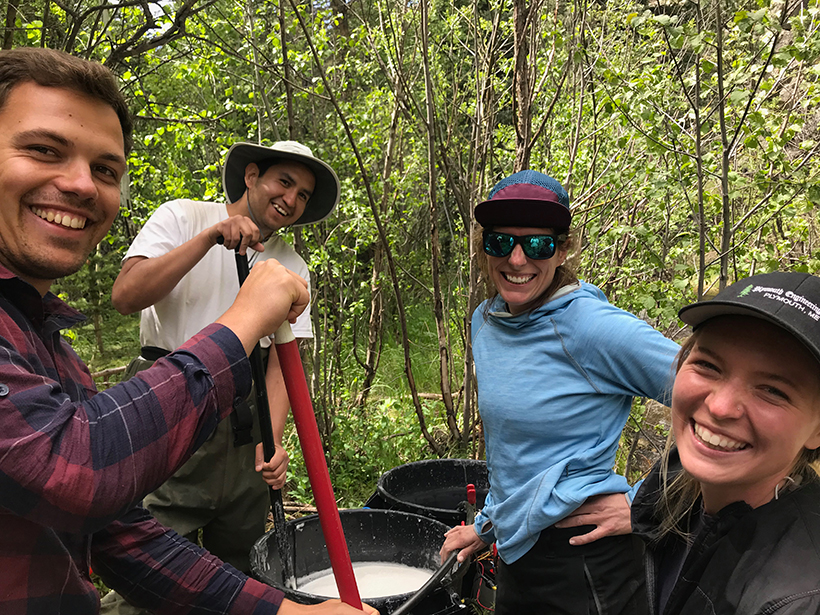Each of us lives on this planet differently. The way in which we are affected by or have an effect on our surroundings changes from person to person, from community to state to nation. As critical zone scientists, perhaps we understand that more than many scientists. We study the layer of our planet from the treetops down to the base of groundwater, where the interactions between our natural habitat and all of Earth’s living creatures are complex and constantly evolving.
If we are to do our research successfully, diverse alliances are important. This truth motivated our group to form the Critical Zone Research Coordination Network (CZ-RCN), launched in 2019 and funded by the National Science Foundation (NSF). Fifteen years ago, NSF established the Critical Zone Observatories, a group of diverse sites around the United States and Puerto Rico selected for intensive critical zone research, and today the observatories are preparing to evolve as critical zone science grows internationally. The data collected from these sites span ecology, hydrology, biogeochemistry, geology, atmospheric science, social science, and even more fields. Many key scientific problems—such as quantifying and predicting the architecture of the critical zone, and how the critical zone evolves and its role in myriad processes controlling ecosystems—remain difficult to tackle, in part because of the convergent perspectives required to think through them.
Many early-career Earth scientists have not heard of the critical zone and do not understand how their work studying rivers or the carbon cycle fits squarely within it.
Unfortunately, because critical zone science is a new approach to transdisciplinary science, few universities offer courses or fieldwork in ways that incorporate related studies under this term. As a result, many early-career Earth scientists have not heard of the critical zone and do not understand how their work studying rivers or the carbon cycle—or any process occurring at Earth’s surface—fits squarely within it. This is a shame, not just for progress in critical zone science but also for those researchers who may miss out on the many benefits the critical zone approach and community offer, including collaborating broadly on problems of societal importance, such as feeding a growing world population or sequestering carbon to mitigate climate change. People who interact with this community often say it has changed the lens through which they conduct science.
More problematic is that because of its relative obscurity, some see critical zone science as an insider’s club—one that touches a huge spectrum of research but excludes all but the few who have managed to get into the observatory clique. What the RCN strives to make clear is that the critical zone approach is open to everyone.
Bringing Diverse Groups into the Zone
The RCN is addressing challenges in uniting disparate scientific disciplines that operate in the critical zone while also addressing the inequities experienced by underrepresented groups that may prevent them from participating fully in their areas of interest. These groups include ethnic and racial minorities, individuals with disabilities, the LGBTQ+ community, veterans, first-generation students, and women.

We know that including different social identities is key to making better science [e.g., Medin and Lee, 2012]. That means first having the demographics of our programs at least match those of the available talent pool and then working to increase the diversity of that pool. To achieve this, we are broadly advertising our efforts, including with groups organized by minoritized scientists such as GeoLatinas, the American Indian Science and Engineering Society, the Earth Science Women’s Network, and more.
The RCN encourages people from different backgrounds to work together and facilitates these relationships, easing the discomfort those experiences can bring. We do this in part by asking senior scientists to share their career paths and experiences in presentations at our meetings, including telling stories about setbacks and other challenges; providing structured opportunities for participants to network broadly; and leveling the playing field by talking about skills that not all trainees are taught, such as navigating the NSF proposal system and managing imposter syndrome.
We integrate career development and networking opportunities into our scientific workshops on an equal footing with scientific talks.
We are also offering financial support for conference travel to scientists from programs lacking significant resources. We integrate career development and networking opportunities into our scientific workshops on an equal footing with scientific talks.
For example, at the RCN event Bringing the Science Home! A Cybersymposium for Earth Surface Scientists, held in June 2020, a professor shared their nonlinear path from being a high school student who wanted to pursue physics, to finding work as a bartender and drywaller, to eventually becoming a professor of geophysics. Although traditional, direct paths are usually more valued by academia, such divergence resonates much more with the broader community of scientists who have had varied experiences and struggles. We argue that it is crucial to integrate these perspectives into the traditionally elite table of academia. Diverse experiences and collaborations broaden our definition of societally important problems and contribute to more innovative solutions to solve them.
Every individual has unique experiences on this thin layer of Earth where the critical zone is defined, which in turn defines our worldviews and what we think is meaningful. For example, some Native Americans consider water an ancestor rather than a resource to be used at will [e.g., Fox et al., 2017]. These differences in values deepen the conflicts around such issues as building the Dakota Access and Keystone XL pipelines [Fernández-Llamazares et al., 2020]. This relationship with nature, called kincentric ecology by Salmón [2000], views different parts of natural systems as a whole and resembles the interdisciplinary and systems approaches that critical zone science undertakes.
Accessibility Means Including the Community

The RCN also aims to develop an inclusive vocabulary within the field of critical zone science. By making our work more accessible, we include in the conversation people with different expertise who may help crack some of the difficult problems we face in critical zone research. These problems require working not just across scientific disciplines and with diverse scientists but also with nonscientists: understanding how resilient our water supplies are to changing climatic conditions, how the critical zone feeds back to control climatic conditions, and how changes in anthropogenic atmospheric emissions affect the viability of the critical zone.
One presentation from our recent cybersymposium, for instance, highlighted working with farmers who want to grow healthy and hardy crops while also conserving water and minimizing water pollution. Scientists on the project listened to the farmers’ experiences and integrated that knowledge into their models, which the farmers were able to learn from and integrate into their practices. This communication could not have happened without an inclusive vocabulary.
We can’t do any of this, however, if we don’t have diverse viewpoints at the table. We must value and measure the effort put in by those recruiting new participants in the same way we value traditional scientific output, such as publishing. It is critical that this effort not be relegated only to minoritized scientists. Everyone should be trained in fostering inclusion, giving and receiving constructive criticism and feedback, learning from mistakes, and coming to the realization that as we improve our approaches, no single approach will fit all scenarios.
Critical Heavy Lifting
Scientists who have already experienced success in their careers—those who have gained tenure and are leading research—must do the heavy lifting to make critical zone science more inclusive. This task should especially be taken on by the many white scientists who have gained success through privilege, which may leave them with a limited view of Earth systems problems. Senior scientists need to change their view of mentoring the next generation from a one-way learning experience to a rich partnership. Veteran scientists can learn a lot from early-career scientists, who may be in different critical zone research fields and who also have experience in communicating with a broader demographic and in different ways (e.g., by social media).
What feel like intractable problems in the critical zone may remain that way unless we can bring in new people interested in transdisciplinary science along with their new ideas and enable communication across disciplinary, methodological, racial, economic, and religious boundaries.
Enhancing diversity throughout the science, technology, engineering, and mathematics (STEM) fields means learning some cultural humility. Everyone comes to the table with their past experiences; the question is how to support the sharing of those experiences so that everyone feels included and valued. What feel like intractable problems in the critical zone may remain that way unless we can bring in new people interested in transdisciplinary science along with their new ideas and enable communication across disciplinary, methodological, racial, economic, and religious boundaries.
By bringing new groups of individuals together, we stimulate creative and diverse ways of conceptualizing problems and synthesizing solutions that will only improve critical zone research. The RCN is collecting the resources we have found helpful for others to use in their efforts to expand inclusion in their disciplines, even outside critical zone science. We look forward to working with our broader geosciences community to grow diversity, inclusion, and access in critical zone science and STEM fields writ large.
References
Fernández-Llamazares, Á., et al. (2020), A state-of-the-art review of Indigenous Peoples and environmental pollution, Integrated Environ. Assess. Manage., 16(3), 324–341, https://doi.org/10.1002/ieam.4239.
Fox, C. A., et al. (2017), “The river is us; the river is in our veins”: Re-defining river restoration in three Indigenous communities, Sustainability Sci., 12(4), 521–533, https://doi.org/10.1007/s11625-016-0421-1.
Medin, D. L., and C. D. Lee (2012), Diversity makes better science, Am. Psychol. Assoc. Observer, 25(5).
Salmón, E. (2000), Kincentric ecology: Indigenous perceptions of the human–nature relationship, Ecol. Appl., 10(5), 1,327–1,332, https://doi.org/10.2307/2641288.
Author Information
Kamini Singha ([email protected]), Colorado School of Mines, Golden; Pamela L. Sullivan, Oregon State University, Corvallis; Li Li, Pennsylvania State University, University Park; and Nicole M. Gasparini, Tulane University, New Orleans, La.
Citation:
Singha, K.,Sullivan, P. L.,Li, L., and Gasparini, N. M. (2020), Demystifying critical zone science to make it more inclusive, Eos, 101, https://doi.org/10.1029/2020EO148937. Published on 24 September 2020.
Text © 2020. The authors. CC BY-NC-ND 3.0
Except where otherwise noted, images are subject to copyright. Any reuse without express permission from the copyright owner is prohibited.


